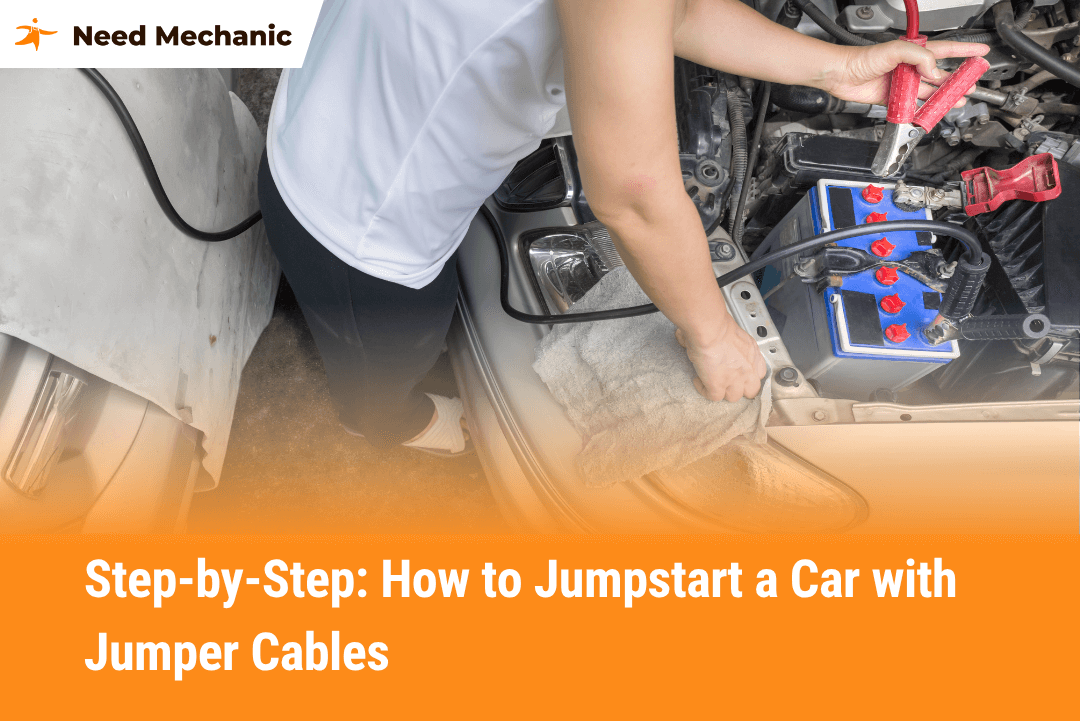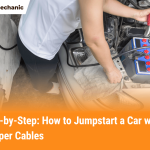Jumpstarting a car with jumper cables means using another vehicle’s battery to give your dead battery the power it needs to turn over the engine. In just a few easy steps – connecting cables in the right order, waiting for the charge to flow, and then starting your car, you can get back on the road without calling for roadside assistance. This guide explains exactly what you need, how to set up and connect the cables safely, and how to avoid common mistakes. You’ll also find tips on preparing ahead of time and signs that it’s better to call a professional. Follow along, and you’ll be ready to jumpstart any stalled car quickly, confidently, and without extra stress.
Table of Contents
- Why Knowing How to Jumpstart a Car Matters
- What You’ll Need to Jumpstart a Car
- Step-by-Step Guide to Jumpstarting a Car with Jumper Cables
- Common Mistakes to Avoid When Jumpstarting a Car
- When to Seek Professional Help
- Tips to Prevent Future Dead Batteries
- Why This Skill Saves You Time and Money
- Final Thoughts
Why Knowing How to Jumpstart a Car Matters
A dead car battery is one of the most common vehicle issues drivers face. Whether it’s due to leaving headlights on, cold weather, or an aging battery, a dead battery can leave you stranded at the worst possible moment. Learning how to jumpstart a car with jumper cables empowers you to take control, avoid costly towing fees, and get moving without waiting for roadside assistance. This skill is especially useful for drivers, where local mechanics and tow services might not always be immediately available, especially in rural areas or during peak hours.
By mastering this simple process, you can save hours of frustration and keep your day on track. Plus, it’s a practical skill that anyone with access to jumper cables and another vehicle can learn. Let’s dive into what you’ll need and how to do it safely and effectively.
What You’ll Need to Jumpstart a Car
Before you begin, gather the necessary tools and ensure you’re prepared. Having the right equipment and knowledge makes the process smoother and safer. Here’s what you’ll need:
- Jumper cables: Ensure they’re in good condition, with no frayed wires or damaged clamps.
- A working vehicle: This car will provide the power to jumpstart your dead battery.
- Safety gear: Gloves and safety glasses protect you from sparks or battery acid.
- A clean cloth or wire brush: Useful for cleaning dirty battery terminals.
- Optional: Battery charger or portable jumpstarter: If another vehicle isn’t available, a portable jumpstarter can work.
If you don’t own jumper cables, they’re affordable and widely available at auto parts stores or online. Investing in a good pair is a smart move for any driver.
Step-by-Step Guide to Jumpstarting a Car with Jumper Cables
Follow these steps carefully to jumpstart your car safely and get back on the road. Each step is designed to be clear and easy to follow, even if you’ve never done this before.
Step 1: Prepare Both Vehicles
Park the working vehicle close to the car with the dead battery, but ensure the cars don’t touch. This prevents unwanted electrical connections. Turn off both vehicles’ ignitions, lights, and accessories (like radios or AC) to avoid draining the working battery or causing electrical surges. Engage the parking brakes on both cars for safety.
Step 2: Inspect the Batteries
Locate the batteries in both vehicles usually under the hood, but check your owner’s manual if you’re unsure. Look for the positive (+) and negative (-) terminals on each battery. If the terminals are dirty or corroded, gently clean them with a cloth or wire brush to ensure a good connection.
Safety Tip: Never touch the positive and negative terminals together, as this can cause sparks or damage the battery.
Step 3: Connect the Jumper Cables
Here’s where you need to be precise. Follow this exact order to connect the jumper cables safely:
- Attach one red clamp to the positive (+) terminal of the dead battery.
- Attach the other red clamp to the positive (+) terminal of the working battery.
- Attach one black clamp to the negative (-) terminal of the working battery.
- Attach the other black clamp to an unpainted metal surface on the engine block or frame of the car with the dead battery (not the negative terminal). This acts as a ground and reduces the risk of sparks.
Double-check that the clamps are secure and not touching each other.
Step 4: Start the Working Vehicle
Turn on the working vehicle and let it idle for 2–3 minutes. This allows the working battery to send power to the dead battery. If the dead car has a severely drained battery, you may need to wait a bit longer.
Step 5: Attempt to Start the Dead Car
Try starting the car with the dead battery. If it doesn’t start right away, wait another minute or two and try again. If it still doesn’t start after a few attempts, the battery may be too weak, or there could be another issue (like a faulty alternator). In this case, you may need professional help from a local mechanic.
Step 6: Disconnect the Cables
Once the dead car is running, carefully remove the jumper cables in the reverse order:
- Remove the black clamp from the unpainted metal surface on the dead car.
- Remove the black clamp from the negative (-) terminal of the working battery.
- Remove the red clamp from the positive (+) terminal of the working battery.
- Remove the red clamp from the positive (+) terminal of the dead battery.
Store the cables safely to avoid tangling or damage.
Step 7: Keep the Car Running
Drive or let the revived car run for at least 15–20 minutes to recharge the battery. A short drive around Los Angeles or idling in your driveway works. Avoid turning on accessories like the radio or AC during this time to let the alternator focus on charging the battery.
Common Mistakes to Avoid When Jumpstarting a Car
Even with the best intentions, mistakes can happen. Here are some pitfalls to watch out for to ensure a smooth and safe jumpstart:
- Incorrect cable connection: Always follow the correct order (red to positive, black to negative/ground). Connecting cables incorrectly can damage the battery or electrical system.
- Using damaged cables: Frayed or worn-out jumper cables can cause sparks or fail to transfer power effectively.
- Touching clamps together: This can create sparks or short-circuit the battery, posing a safety hazard.
- Ignoring safety precautions: Always wear gloves and safety glasses, and avoid smoking or open flames near the battery, as batteries can release flammable gases.
- Not letting the car run long enough: Turning off the car too soon after jumpstarting may prevent the battery from recharging properly.
By avoiding these mistakes, you’ll reduce risks and increase your chances of success.
When to Seek Professional Help
While jumpstarting a car is usually straightforward, there are times when it’s best to call a professional. If your car still won’t start after multiple attempts, the issue might not be the battery. Common culprits include a faulty alternator, starter motor, or wiring problems. In USA, you can find reliable auto repair shops or mobile mechanics who can diagnose and fix the issue quickly.
Additionally, if you notice any of the following, skip the jumpstart and call for help:
- A cracked or leaking battery.
- Strange smells (like rotten eggs) or smoke coming from the battery.
- No power at all, even after connecting the cables correctly.
Tips to Prevent Future Dead Batteries
Once you’ve jumpstarted your car, you’ll want to avoid this hassle in the future. Here are practical tips to keep your battery in good shape:
- Turn off accessories: Always check that headlights, interior lights, and electronics are off when you leave your car.
- Regular maintenance: Have your battery tested annually, especially before winter in Texas, as cold weather can strain batteries.
- Drive regularly: Short trips don’t give your battery enough time to recharge. Aim for at least one 20-minute drive per week.
- Invest in a battery charger: A portable charger or trickle charger can keep your battery healthy, especially if you don’t drive often.
By following these habits, you can extend your battery’s lifespan and reduce the need for future jumpstarts.
Why This Skill Saves You Time and Money
Mastering how to jumpstart a car with jumper cables isn’t just about getting out of a bind it’s about taking charge of your vehicle and your schedule. Instead of waiting hours for a tow truck or paying for roadside assistance, you can solve the problem in minutes. For Chicago drivers, this is especially valuable during busy times like rush hour or in remote areas where help might be far away. Plus, jumper cables are a one-time purchase that can last for years, making this a cost-effective solution for any driver.
Final Thoughts
A dead car battery doesn’t have to ruin your day. By following this step-by-step guide on how to jumpstart a car with jumper cables, you can quickly and safely get back on the road. From preparing your tools to connecting cables correctly, each step is designed to be simple and effective, even for beginners. Avoid common mistakes, prioritize safety, and take steps to maintain your battery to prevent future issues. Whether you’re in New York or anywhere else, this skill empowers you to handle a dead battery with confidence, saving you time, money, and stress.
If you found this guide helpful, keep a set of jumper cables in your trunk and share this knowledge with friends or family. You never know when it might come in handy!
How to jump start a car with jumper cables safely?
Follow four steps: red to + dead battery, red to + good battery, black to – good battery, then ground the final black to metal on dead car. Safe and clear.
What is the correct order to hook up jumper cables?
Use: red to dead +, red to good +, black to good –, then black to an unpainted metal ground on the dead car. Avoid sparks and wrong hookups.
How long should cars run after a jump start?
Let both cars idle for 2–3 minutes before starting the dead one. Afterwards drive or run the revived car for at least 15–20 minutes to recharge.
What safety gear do I need to jump a car battery?
Wear gloves and safety glasses and ensure batteries aren’t cracked or leaking. Avoid sparks and never smoke near the battery.
What if the car still won’t start after jumping?
Wait a few more minutes with cables still connected. If it still fails, battery may be bad or alternator faulty—call a mechanic instead.
What common mistakes to watch for during jump starts?
Don’t reverse cable polarity, avoid touching clamps together, and don’t connect negative to dead battery’s – terminal directly. Be careful.
Can I jump start a hybrid or automatic car with cables?
Yes, following the same cable sequence works for most automatics and hybrids. Consult the manual and only jump the 12V battery.
How to clean battery terminals before jumping a car?
Use a clean cloth or wire brush to remove corrosion before clamping. This ensures a strong connection and reduces spark risk.




Leave a Reply